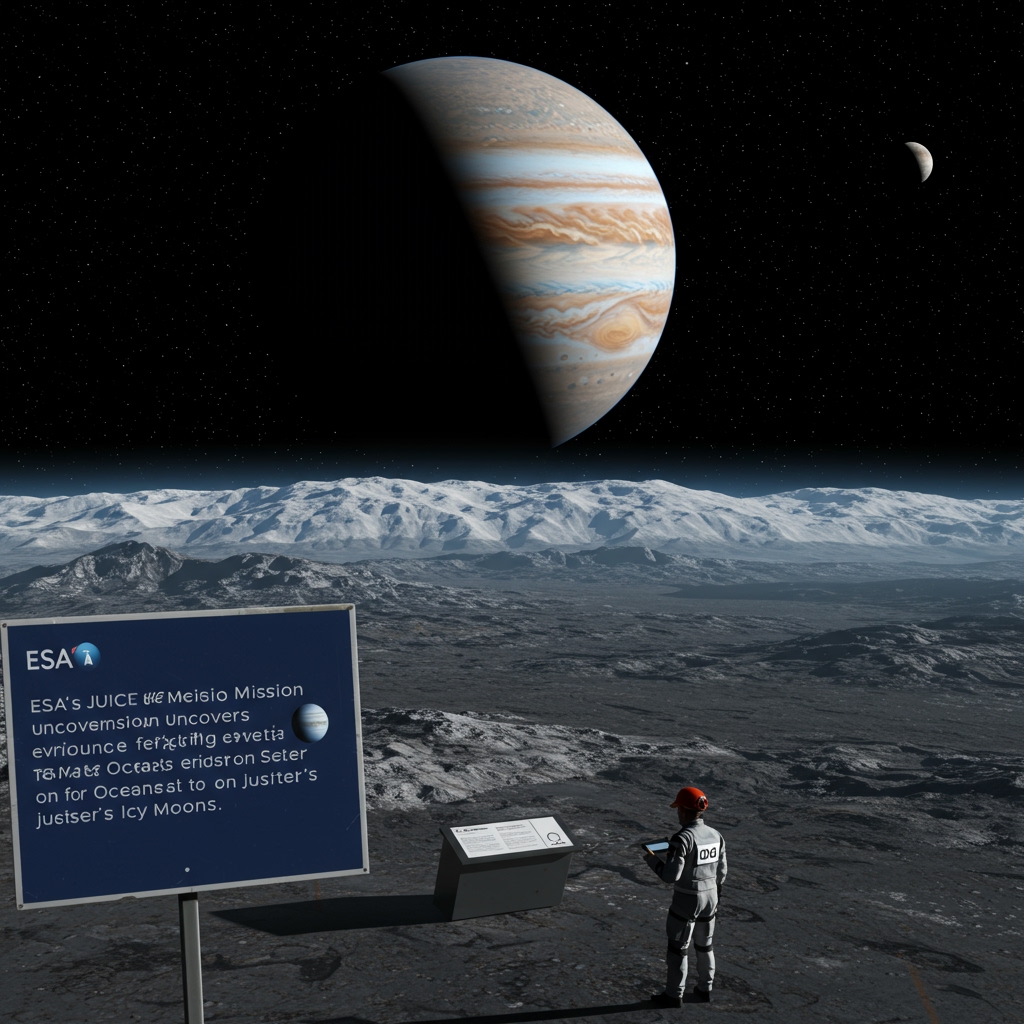ESA Reveals First Insights from JUICE Mission, Pointing to Habitable Potential on Jupiter’s Moons
DARMSTADT, Germany – The European Space Agency (ESA) announced significant preliminary findings from its pioneering Jupiter Icy Moons Explorer (JUICE) mission during a highly anticipated press briefing held on Monday. These initial results, drawn from early observations and instrument activations, provide compelling new evidence strongly supporting the long-held hypothesis that several of Jupiter’s large icy moons harbor vast oceans of liquid water beneath their frozen crusts.
The JUICE mission, which launched in April 2023, is on a multi-year journey to explore the emergence of habitable worlds around gas giants, with a particular focus on three of Jupiter’s largest moons: Ganymede, Callisto, and Europa. All three are thought to possess subsurface liquid water oceans, making them prime targets in the search for environments potentially suitable for life beyond Earth. While Europa is also a key target, JUICE is specifically designed to perform multiple flybys of Ganymede and Callisto before entering orbit around Ganymede in 2034, the first spacecraft ever to orbit a moon other than our own.
Instruments Delivering Crucial Data
The preliminary data discussed during the briefing was collected during JUICE’s commissioning phase and its initial trajectory corrections and flybys. A standout instrument contributing to these early insights is the Radar for Icy Moon Exploration (RIME). RIME is a first-of-its-kind ice-penetrating radar designed to probe the subsurface structure of the icy moons down to depths of several kilometers. By analyzing how radar waves reflect off different layers within the ice crust and potentially from a liquid water boundary, scientists can infer the presence and characteristics of subsurface oceans.
While the mission is still in its cruise phase and has not yet begun its intensive study of the Jovian system moons in close proximity, data acquired during recent trajectory adjustments and the Earth-Moon gravity assist flyby provided valuable opportunities to test and calibrate instruments like RIME and obtain initial measurements. It is this early data, despite the significant distance from Jupiter, that has already yielded results bolstering the ocean hypothesis.
Evidence Mounts for Subsurface Oceans
The analysis presented by ESA scientists indicates that the early data, particularly from RIME, aligns strongly with models predicting deep liquid water layers beneath the icy shells of Ganymede and, to a significant extent, Callisto. Ganymede, being the largest moon in the solar system and the only one known to generate its own magnetic field, is considered a prime candidate for possessing a substantial subsurface ocean. The new data from JUICE appears to reinforce this, providing more concrete geophysical indicators.
Callisto, though less geologically active than Ganymede or Europa, is also believed to host an internal ocean. The preliminary JUICE data on Callisto is described as providing compelling support for this theory as well, suggesting the presence of liquid water layers, although their extent and depth might differ from Ganymede.
These findings are crucial because the presence of liquid water, especially in contact with a rocky core (as is suspected for these moons), provides the necessary conditions for complex chemical interactions that could potentially support life. While the findings do not confirm the existence of life, they significantly strengthen the argument that these icy moons are among the most promising environments in the solar system to investigate for potential habitability.
The Significance for Astrobiology
The data released Monday underscores the strategic importance of the JUICE mission in the field of astrobiology. If confirmed and further characterized by subsequent mission phases, the presence of extensive subsurface oceans on multiple Jovian moons suggests that liquid water might be a more common feature in the solar system than previously thought, potentially existing in places far from the Sun’s heat, sustained by internal processes.
Scientists emphasize that this is just the beginning. The data shared represents only a small fraction of what JUICE is designed to collect over its operational lifetime. The instruments are expected to provide much higher-resolution and more detailed information as the spacecraft gets closer to Jupiter and its moons, especially during the dedicated flybys and the eventual orbit around Ganymede.
Looking Ahead: More Data and Scientific Papers Expected
ESA officials reiterated that the mission is proceeding as planned, with all instruments performing well. The preliminary findings are a positive indicator of the mission’s potential to deliver groundbreaking science. As JUICE continues its journey through the solar system and begins its intensive study phase upon arrival in the Jovian system, vast amounts of new data will be acquired.
The scientific community eagerly anticipates the detailed analysis of this forthcoming data. The agency stated that further detailed scientific papers based on the comprehensive processing and interpretation of the data collected during the mission’s various phases are expected to be released in the future. These papers will provide a much deeper understanding of the internal structure, composition, and potential habitability of these fascinating icy worlds, potentially reshaping our understanding of where life could exist beyond our own planet. The mission’s success in confirming and characterizing these oceans is a vital step in humanity’s quest to understand the prevalence of habitable environments in the cosmos.





